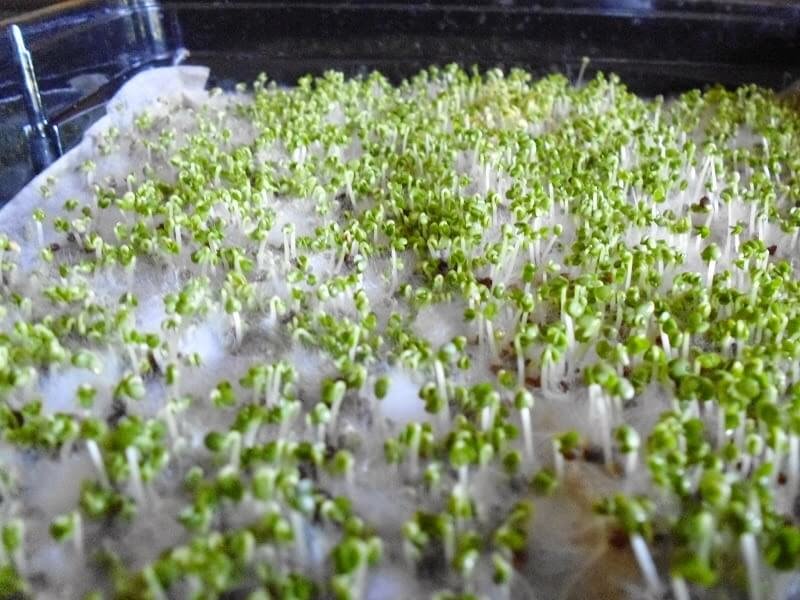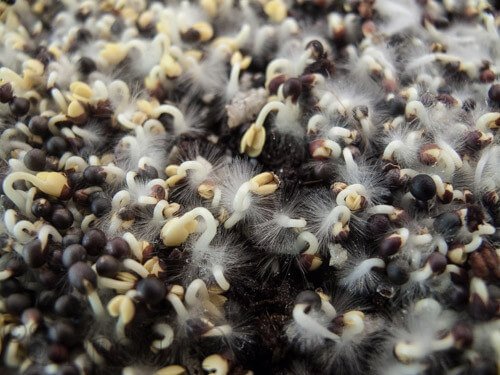It can be very disheartening when your microgreens are growing really well and then they suddenly appear to have mold on them.
Your first thought will probably be to get rid of the entire crop. But, you don’t have to be that drastic!
Instead, take a look at this article and discover what mold on microgreens actually looks like, how it forms, and how to prevent/remedy it.
With a little help, you can beat the mold and be enjoying your microgreens in no time!
What does mold look like on microgreens?
The first thing to understand is that there is a difference between mold and root hairs. Every plant has tiny hairs that form part of the root. They stick out from the lowest part of the plant and help to increase the surface area; allowing your microgreens to absorb all the water they need.

At a glance, these tiny hairs can look like mold, but there are some key differences that will tell you it’s root hair not mold on microgreens:
- Mold looks like a fine spider-web, root hairs are fuzzier.
- Mold is slimy if you touch it but the root airs are not.
- Root hairs only exist on the root; your old will grow anywhere on the plant.
Top Tip: Water your microgreens to see if the root hairs lie flat, in effect they will disappear. Mold doesn’t do this!

How does the mold form?
Mold on microgreens is the same as mold in any other environment; it needs bacteria, moisture, and slow-moving air. If you alter the conditions your microgreens are living in, you can deprive the mold of everything to needs to survive; effectively killing it.
Will Mold Affect The Microgreens?
If there is mold on your microgreens then they will probably continue to grow but they will not be safe to eat. You’ll need to wash the microgreens and then cook them at a high temperature to ensure the mold has gone. Unfortunately, this will also destroy the goodness in your plants; making you wonder why you’ve grown them.
The mold spores can also stay in the growing medium and affect the next batch of plants!
How to prevent mold on microgreens
There are several things you can do to help prevent mold from forming in the first place.
-
Ventilation
Mold doesn’t like moving air, it doesn’t give it the chance to breed and multiply as the bacteria are moved on before they can be really effective.

This is why it is essential to ensure ventilation at every step if the growing process. When you’re germinating your microgreens they are generally covered and at higher risk of mold due to minimal air flow.
To prevent mold on microgreens simply add a couple of ventilation slots to the side of your lid and then place a fan next to the tray. This can be turned on for 15-30 minutes of every hour, refreshing the air around the plants and keeping the mold at bay.
-
Light and temperature
Mold is not a fan of bright lights, as soon as germination has occurred you can move your plants into the light. However, artificial lights are not always the best option for your microgreens. You’ll probably prefer to put them in indirect sunlight; giving them enough light without excessively drying them out.
If sunlight isn’t an option then a grow light, or a standard fluorescent light is a good option; it will help your plants to grow while keeping the sun away.
-
Clean flats with hydrogen peroxide or bleach
Before you starting growing or even germinating your microgreens it is important to clean all your equipment thoroughly.
You can clean the trays with a 1500ml spray bottle; it will need 50ml of hydrogen peroxide, 50ml of white vinegar, and the rest can be normal water.
Wash your trays and other equipment with this solution before sterilizing the growing medium and sanitizing the seed.
It should be noted that you can only sanitize seed that can be soaked before growing. Simply place them in a bowl of water with a teaspoon of hydrogen peroxide. Leave them to soak for a couple of hours and then proceed as normal with planting.
This will kill any infection already present in the seed and help to ensure that you don’t suffer from the mold on microgreens.
-
Humidity control
Mold loves moisture, in fact, it is essential to its survival. Unfortunately, your plants also need water to survive, having moisture in the growing medium is essential.

But you can remove moisture in the air without affecting your microgreens. To do this you simply need to invest in a cheap dehumidifier. Having it on a few times a day will get rid of the moisture; making it very hard for the mold to survive and flourish.
-
Avoid Bunching Seeds
It is also worth noting that bunching the seeds up will lead to a concentration of moisture and a lack of airflow; due to the growing microgreens blocking air movement.
That will encourage mold growth. Try to spread your seed so that there is a little room around each one; your plants will grow better for it.
How to remedy mold on microgreens
Taking the right preventative steps should help to stop the mold on microgreens from appearing. But, if these steps haven’t been successful you can still resolve the issue on the growing plants.
There are a couple of things you can do:
-
Hydrogen peroxide with water
Grab your water spray bottle with a mixture of water, white vinegar, and hydrogen peroxide. You can spray this over your plants; it will kill the mold growing on them.
Use a 3% hydrogen peroxide solution. If you use a strong solution and mix it together with vinegar is creates peracetic acid, which is potentially toxic and can irritate your skin, eyes, and your respiratory system (thanks to Eleni Patsa for the mention).
However, don’t make the mixture too strong, if you do you’ll end up burning the leaves of your microgreens; as well as killing the mold.

Top Tip: Don’t try to rub the stems of the plants; they are too delicate and you’ll damage the root hairs; making it likely that they’ll die.
-
Sunlight
Sunlight is good for plants and something that mold doesn’t like. If you are experiencing some sunny days then place your plants in direct sunlight; it will help to dry and destroy the mold.
However, it will also dry out your microgreens. You’ll need to place a water tray under the growing medium tray. Keep this watered and monitor your microgreens; they should get the water they need from the water tray without giving the mod any additional moisture.
This will also improve the drainage of the soil, reducing the risk of mold on microgreens and preventing you from having to deal with the issue!
A final thought that can work, is to remove the moldy plant, or affected part of the plant. This can prevent the mod from spreading. But, mold can be difficult to see in its early stages, you may simply be removing plants without winning the war on mold on microgreens; proceed with caution.

I am using a 15l spray bottle. I mix l of hydrogen peroxide with l of white vinegar, and top with water. It s quite effective. However, please be knowing that too much of this solution can burn your microgreens.
You stare you’re using a 1:1 ratio of vinegar & peroxide. Unkess I’m overlooking it, you don’t appear to say the amounts used. A few drops? 1/2 Teaspoon?
Please clarify. Thanks!
How many percent hydrogen peroxide solution should I get? There are so many in the market. 3% 50% etc….
Hello Pamela, You should get a 3% hydrogen peroxide solution. Mix equal parts of hydorgen peroxide with water.
Disregard my question. I have no idea how I missed seeing the amounts of hydrogen peroxide & vinegar to water🥺
You should NOT be mixing vinegar with hydrogen peroxide! It is not safe.
Thanks Eleni, I have mentioned it in the article.